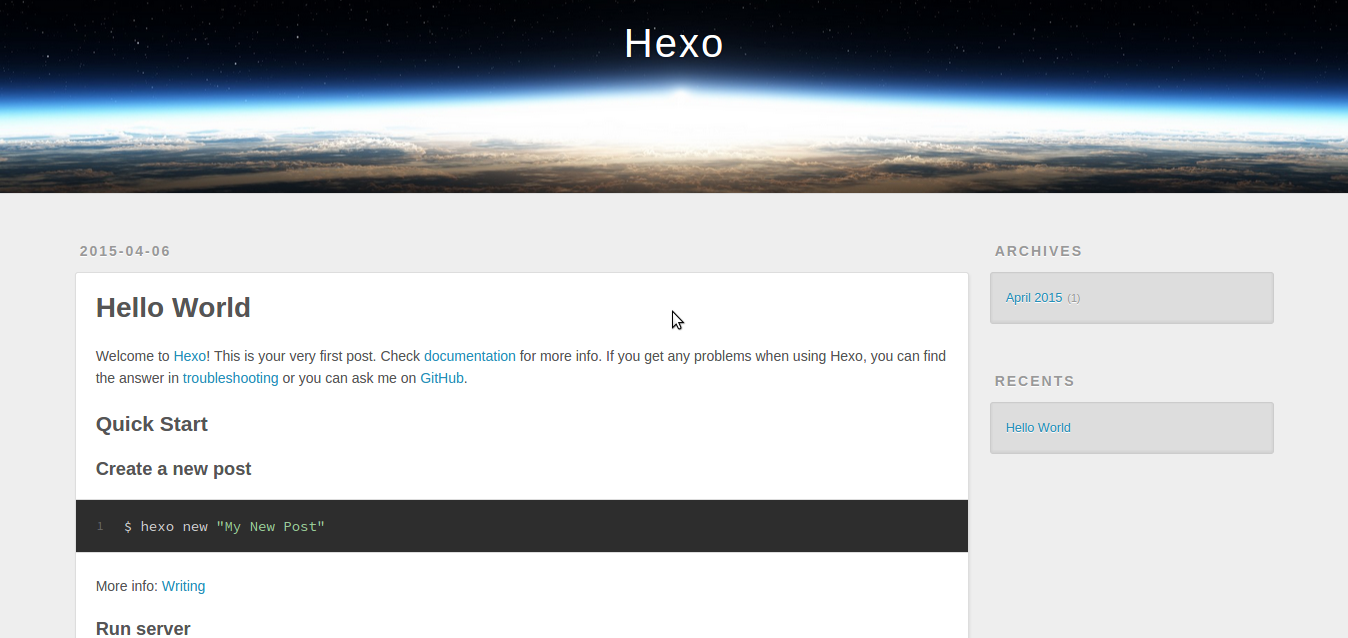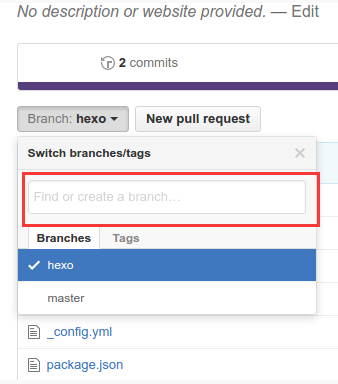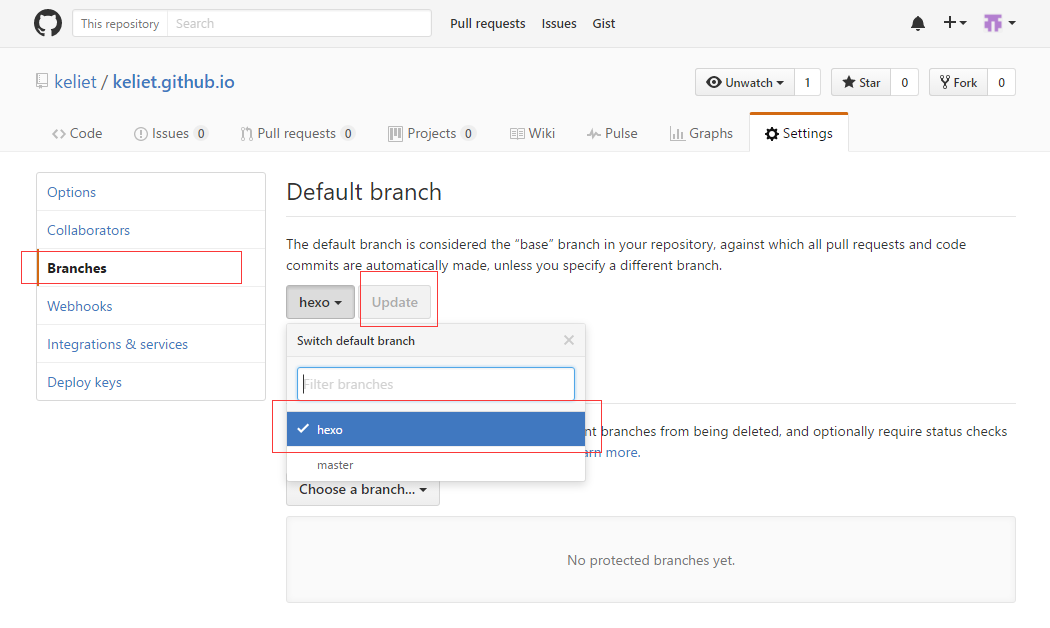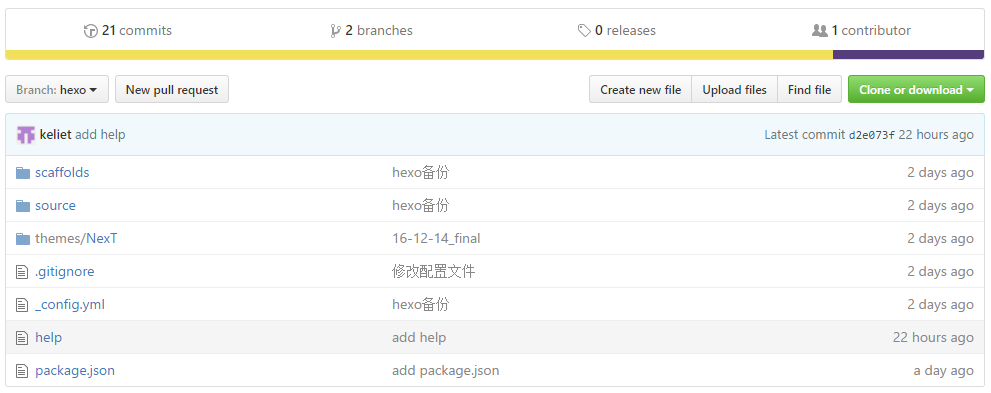
搭建过程
在开始之前,简单说明一下整个博客的一个搭建过程:
- 本地部署
- 远程部署
- 图片存储
- 写文章
- 发布
本地部署
安装相关软件
安装Git和Node.js
安装过程一路默认,需要的话可更改安装目录
安装Hexo
Hexo的安装需要借助Node.js的npm命令,可以理解为Hexo是Node.js的模块。操作的方式是在任意的位置单击鼠标右键,选择Git bash命令,或者直接点击Git Shell快捷方式,在里面输入:1
npm install -g hexo
其中-g代表使用全局安装;卸载的话,将上面的命令中的intall更换为uninstall就可以了。
初始化Hexo
在某个盘符下创建一个目录,重命名(最好是英文),例如你在D盘中创建了一个blog目录,那么路径就是D:\blog,后续的很多操作都会在这个目录中;在该目录单击右键,选择Git bash,输入以下命令:1
hexo init
成功后,会在选中目录中自动生成如下结构

安装依赖包1
npm install
成功后,会在选中目录中自动生成node_modules目录;一系列的安装后,本地博客就搭建完毕了,输入如下的命令(也可以利用组合命令)先输入hexo g再输入hexo s1
2
3
4
5D:\blog> hexo g
INFO Start processing
INFO Files loaded in 558 ms
INFO Generated:
\\省略部分结果
使用hexo g,不出意外,会在blog目录中生成public目录和db.json文件,其中public就是我们博客的静态页面,远程部署的时候就是将该目录中的所有文件上传至服务器。1
2
3D:\blog> hexo s
INFO Start processing
INFO Hexo is running at http://localhost:4000/. Press Ctrl+C to stop.
组合命令:hexo s -g1
2
3D:\blog> hexo s -g
INFO Start processing
INFO Hexo is running at http://localhost:4000/. Press Ctrl+C to stop.
在浏览器中地址栏输入localhost:4000就可以看到本地部署的效果了,就如下图的样子,这里的是本地博客,其他地方还看不到的;
安装Hexo主题
使用Hexo更换主题还算方便,先使用克隆命令安装好主题,然后更改一下博客的配置文件D:\blog_config.yml里面的主题名称就好了。关于主题的选择,每个人的喜好不同,你可以到Hexo官方主题页面选择自己喜欢的主题。我选用的是经过自己修改的NexT主题。后面都是针对于NexT主题的介绍。说明一点:使用他人的主题,一定要保留主题作者的信息(在博客最下面显示),表示对作者的尊重。
遇到喜欢的主题后,找到主题的github链接;在blog目录下右键单击选择Git Bash,输入以下命令:1
git clone https://github.com/iissnan/hexo-theme-next.git themes/next
在blog目录的themes文件夹下会找到获得的主题文件夹next;之后在blog目录下的_config.yml文件中找到如下字段:1
2## Themes: https://hexo.io/themes/
theme: landscape #将该字段更改我们新获取的主题文件夹名就好
我这里是使用的next主题,就将该字段更改为next
博客配置
博客搭建完毕,就可以根据自己的爱好对Hexo生成的网站进行设置了,对整站的设置置分为整体配置和主题配置。
先来看看博客的整体配置,也就是打开blog目录中的_config.yml文件,更改里面的部分内容。1
2
3
4
5
6
7
8
9
10
11
12
13
14
15
16
17
18
19
20
21
22
23
24
25
26
27
28
29
30
31
32
33
34
35
36
37
38
39
40
41
42
43
44
45
46
47
48
49
50
51
52
53
54
55
56
57
58
59
60
61
62
63
64
65
66
67
68
69
70
71
72
73
74# Hexo Configuration
## Docs: https://hexo.io/docs/configuration.html
## Source: https://github.com/hexojs/hexo/
# Site
title: #填写网站名,会在标签页上显示
subtitle: #网站副标题
description: #网站描述,便于搜索引擎用关键词检索
author: #作者
language: zh-Hans #语言,具体配置与使用主题有关,查看主题文档
#URL
## If your site is put in a subdirectory, set url as 'http://yoursite.com/child' and root as '/child/'
url: http://yoursite.com
root: /
permalink: :year/:month/:day/:title/
permalink_defaults:
# Directory
source_dir: source
public_dir: public
tag_dir: tags
archive_dir: archives
category_dir: categories
code_dir: downloads/code
i18n_dir: :lang
skip_render:
# Writing
new_post_name: :title.md # File name of new posts
default_layout: post #l post 、draft、page #文章、草稿、页面
titlecase: true # Transform title into titlecase
external_link: true # Open external links in new tab
filename_case: 0
render_drafts: false
post_asset_folder: false
relative_link: false
future: true
highlight:
enable: true
line_number: true
auto_detect: false
tab_replace:
# Category & Tag
default_category: uncategorized
category_map:
tag_map:
# Date / Time format
## Hexo uses Moment.js to parse and display date
## You can customize the date format as defined in
## http://momentjs.com/docs/#/displaying/format/
date_format: YYYY-MM-DD
time_format: HH:mm:ss
# Pagination
## Set per_page to 0 to disable pagination
per_page: 12 #每页显示12篇文章
pagination_dir: page
archive: 1
category: 1
tag: 1
# Extensions
## Plugins: https://hexo.io/plugins/
## Themes: https://hexo.io/themes/
theme: landscape
fancybox: true
# Deployment
## Docs: https://hexo.io/docs/deployment.html
deploy: #github相关配置,主要用于,将生成网站上传至github
type: git
repo: https://github.com/keliet/keliet.github.io.git
branch: master
有关详细说明请查阅Hexo文档其中有更详细的说明;整体配置设置完以后 。
再来看看主题配置,在主题文件夹下找到_config.yml文件;其中各个字段的说明,请查看next主题的说明文档,已经说的非常清楚了。
Hexo 常用命令说明
远程部署
远程部署流程,简单说明一下整个过程:
- 创建仓库
- 创建分支
- 拷贝仓库
- 部署要上传hexo配置
- 提交网站相关文件
- 生成网站并发布到github上
- 日常使用
创建仓库
远程部署可部署到自己的服务器上,也可以托管到Github上,这里我只说一下Github方式。因为是托管到Github上,所以第一步需要注册一个账号。已有账号的自行忽略。
第一步:建立和用户名相对应的仓库,以我的例子来说,我的用户名是keliet,那么我的仓库就必须是keliet.github.io,否则可能就不成功。
第二步:远程代码是基于SSH的,所以需要SSH的相关配置。方法是现在本地生成SSH公钥,然后添加到Github上面。具体的操作如下:
1、检查你电脑上现有的ssh key:1
ls ~/. ssh 检查本机的ssh密钥
如果提示:No such file or directory 说明没有找到,说明本地没有ssh密钥。
2、生成新的SSH Key:设置你的邮箱和用户名1
2git config --global user.email "keliet1021@gmail.com"
git config --global user.name "keliet"
接下来生成密钥,过程中会要设置密码,输入的密码不显示(第一次为设置密钥文件名,第二和第三就是密码与密码确认)1
ssh-keygen -t rsa -C "keliet@gmail.com"
注意其中的-C是大写。上述的命令成功后,会得到id_rsa和id_rsa.pub两个文件,可能在C:\Users\Administrator\.ssh文件夹里。
3、把ssh密钥添加至Github上
登陆Github后,点击settings,然后进入SSH keys,把id_rsa.pub文件里内容添加进去就好了。
4、配置相关Github信息
编辑D:\blog目录下的配置文件_config.yml,找到deploy字段,输入以下内容1
2
3
4deploy:
type: git
repo: https://github.com/你的用户名/你的用户名.github.io.git
branch: master
输入命令hexo d -g,完成远程部署;出现下面的提示表示部署成功;1
INFO Deploy done: git
部署过程中遇到问题及解决办法:1
2
3
4
5
6
7
8
9
10
11
12
13
14
15
16
17
18
19
20
21
22
23
24
25
26 create mode 100644 vendors/velocity/velocity.min.js
create mode 100644 vendors/velocity/velocity.ui.js
create mode 100644 vendors/velocity/velocity.ui.min.js
replaced by CRLF in vendors/jquery/index.js.
The file will have its original line endings in your working directory.
warning: LF will be replaced by CRLF in vendors/velocity/velocity.js.
The file will have its original line endings in your working directory.
warning: LF will be replaced by CRLF in vendors/velocity/velocity.min.js.
The file will have its original line endings in your working directory.
warning: LF will be replaced by CRLF in vendors/velocity/velocity.ui.js.
The file will have its original line endings in your working directory.
warning: LF will be replaced by CRLF in vendors/velocity/velocity.ui.min.js.
The file will have its original line endings in your working directory.
bash: /dev/tty: No such device or address
error: failed to execute prompt script (exit code 1)
fatal: could not read Username for 'https://github.com': No error
FATAL Something's wrong. Maybe you can find the solution here: http://hexo.io/docs/troubleshooting.html
Error: bash: /dev/tty: No such device or address
error: failed to execute prompt script (exit code 1)
fatal: could not read Username for 'https://github.com': No error
at ChildProcess.<anonymous> (E:\zan\www\gitpages\hexo\zanjs.github.io\node_modules\hexo-deployer-git\node_modules\hexo-util\lib\spawn.js:42:17)
at emitTwo (events.js:87:13)
at ChildProcess.emit (events.js:172:7)
at maybeClose (internal/child_process.js:818:16)
at Process.ChildProcess._handle.onexit (internal/child_process.js:211:5)
解决办法1:
配置Deployment首先,你需要为自己配置身份信息,打开命令行,然后输入:1
2git config --global user.name "yourname"
git config --global user.email "youremail"
以上做完还不行
删掉blog目录下的文件夹.deploy_git,重新deploy就可以了。
解决办法2:
将博客配置_config.yml中的deploy:配置为ssh模式,如下所示1
2
3
4deploy:
type: git
repo: git@github.com:用户名/用户名.github.io.git
branch: master
解决办法3:
找到Github快捷方式,进入后登陆账号即可。
此法,配置还是https1
2
3
4deploy:
type: git
repo: https://github.com/用户名/用户名.github.io.git
branch: master
3种方法适合不同的人,选择自己适用的,如不知道依次试,总有一个可以解决你的问题。
创建分支
因为发布后是覆盖方式,即后一次的发布将完全覆盖上次的发布,如果你有多台电脑,而且每台电脑你都有可能会写博客。那么这个时候就需要对Hexo进行版本控制了。版本控制的主要目的是方便在不同的电脑维护Hexo及写作。这里利用github的分支来保存hexo框架的相关文件(hexo配置、md、主题等文件)到github page仓库。
新建Hexo分支page仓库的master分支用来存放网站文件的,这是GitHub Page的要求,所以只好新建分支来保存Hexo原始文件,在下图的输入框输入分支名并按回车即完成分支创建。
设置默认分支因为我们写博客更多的是更新这个分支,网站文件所在的master分支则由hexo d命令发布文章的时候进行发布,所以我们将hexo分支>设置为默认分支,这样我们在新的电脑环境下git clone该仓库时,自动切到hexo分支。按下图进行操作。
然后使用部署命令hexo g -d就会自动渲染Markdown文件生成静态文件(public文件夹下所有文件)并部署到yourname.github.io仓库的master分支上,这时再访问http://yourname.github.io 就可以看到博客页面了。
拷贝仓库
此时博客页面是部署保存了,但hexo配置、md、主题等文件还没有保存,创建新的文件夹,拷贝仓库,用于将hexo的配置发布到hexo分支上。在新创建的目录中执行以下命令:1
git clone https://github.com/yourname/yourname.github.io.git
部署要上传hexo配置
在新创建的文件夹中,将本地修改好的hexo配置文件拷贝到新创建的目录;需要拷贝的内容见下图;(以下是必须要拷贝的内容)
完成以上的拷贝后就可以提交到hexo分支了。
提交网站相关文件
在新创建的目录中执行以下命令:(用于将hexo配置及主题配置提交到github)1
2
3git add .
git commit -m “你要写的描述”
git push origin hexo
生成网站并发布到github上
这个就比较简单了,如果配置都按以上操作,只要执行hexo g -d后,去刷新你的博客吧。
日常使用
已有环境下
在本地对博客进行修改(添加新博文、修改样式等等)后,通过下面的流程进行管理。
1.同步之前写的博客,在你的仓库目录下执行git pull;
2. 依次执行git add .,git commit -m "..."、git push origin hexo指令将改动推送到GitHub(此时当前分支应为hexo);
3. 然后才执行hexo g -d发布网站到master分支上。
虽然后两个过程顺序调转一般不会有问题,不过逻辑上这样的顺序是绝对没问题的(例如突然死机要重装了,悲催….的情况,调转顺序就有问题了)
新环境
到了新的电脑上时,我们需要将项目先下载到本地,然后再进行本地部署即可。1
2
3
4
5git clone https://github.com/yourname/yourname.github.io.git
cd yourname.github.io
npm install hexo
npm install
npm install hexo-deployer-git –save
之后开始写博客,写好部署好之后,别忘记 git add .,git commit -m "你的描述",git push origin hexo推上去
图片存储
想要在文章中插入图片的话,可以按照Markdown语法来插入,格式图片的存放有两种方式:
1、在本地D:\blog\source目录下新建一个存放图片的文件夹,比如images,然后把想要插入的图片放在里面,插入图片的路径;
2、第二种方法是把图片上传到网络,然后插入图片路径。推荐使用第二种。
本人将图片存在七牛上,在本地任意位置创建图片文件夹,把文章要用的图片存入该文件夹,在七牛开发者中心下载qrsbox,直接运行qrbox,并在其中设置要同步的图片文件夹,图片会自动同步到七牛服务器
写文章
文章格式如下:1
2
3
4
5
6
7
8
9---
title: #文章标题
categories: #文章分类
tags: #文章标签
- Hexo
- Github
date: 2016-12-15 #日期
---
这之后就是文章正文了
写文章本人采用Markdown pad 2